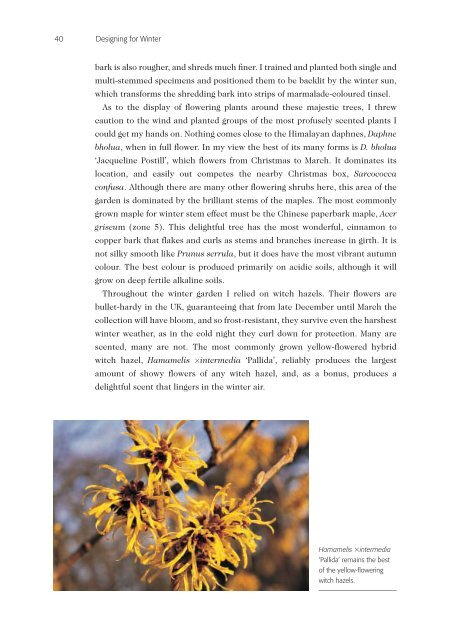Create successful ePaper yourself
Turn your PDF publications into a flip-book with our unique Google optimized e-Paper software.
40 Designing for <strong>Winter</strong><br />
bark is also rougher, and shreds much finer. I trained and planted both single and<br />
multi-stemmed specimens and positioned them to be backlit by the winter sun,<br />
which transforms the shredding bark into strips of marmalade-coloured tinsel.<br />
As to the display of <strong>flowering</strong> plants around these majestic trees, I threw<br />
caution to the wind and planted groups of the most profusely scented plants I<br />
could get my hands on. Nothing comes close to the Himalayan daphnes, Daphne<br />
bholua, when in full flower. In my view the best of its many forms is D. bholua<br />
‘Jacqueline Postill’, which flowers from Christmas to March. It dominates its<br />
location, and easily out competes the nearby Christmas box, Sarcococca<br />
confusa. Although there are many other <strong>flowering</strong> shrubs here, this area of the<br />
garden is dominated by the brilliant stems of the maples. The most commonly<br />
grown maple for winter stem effect must be the Chinese paperbark maple, Acer<br />
griseum (zone 5). This delightful tree has the most wonderful, cinnamon to<br />
copper bark that flakes and curls as stems and branches increase in girth. It is<br />
not silky smooth like Prunus serrula, but it does have the most vibrant autumn<br />
colour. The best colour is produced primarily on acidic soils, although it will<br />
grow on deep fertile alkaline soils.<br />
Throughout the winter garden I relied on witch hazels. Their flowers are<br />
bullet-hardy in the UK, guaranteeing that from late December until March the<br />
collection will have bloom, and so frost-resistant, they survive even the harshest<br />
winter weather, as in the cold night they curl down for protection. Many are<br />
scented, many are not. The most commonly grown yellow-flowered hybrid<br />
witch hazel, Hamamelis intermedia ‘Pallida’, reliably produces the largest<br />
amount of showy flowers of any witch hazel, and, as a bonus, produces a<br />
delightful scent that lingers in the winter air.<br />
Hamamelis intermedia<br />
‘Pallida’ remains the best<br />
of the yellow-<strong>flowering</strong><br />
witch hazels.


